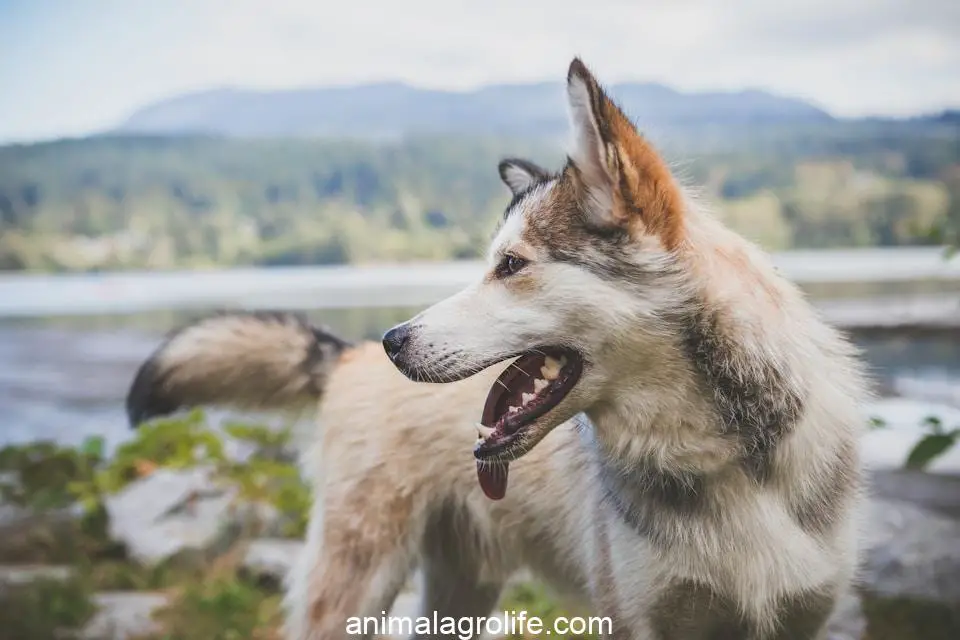Yes, dogs can feel their tails! Learn why their tails are sensitive, how they use them, and what tail injuries mean for your pup.
jump to topic
Signs of a Dog Using & Feeling Their Tail
Dogs use their tails all the time, and it tells us a lot about how they’re feeling. Here’s what to look for:
- Happy Wagging: Fast tail-wagging often means a dog is excited and joyful.
- Slow, Low Wagging: A nervous or unsure dog might wag their tail slowly and keep it low to the ground.
- Tucked Tail: Tucking its tail between its legs is a big sign that a dog is scared or feeling submissive.
- Alert & Stiff: A dog holding its tail high and rigid is focused or might even be feeling aggressive.
Tails aren’t just for talking! Your dog uses their tail for physical stuff too:
- Balance: Their tail acts like a counterweight, helping them stay balanced when running and turning.
- Swimming: Some dogs, like Labradors, use their tail as a rudder to steer in the water.

History of Dogs and Their Tails
Dogs descended from wolves, and wolves need their tails for all sorts of things, including communicating, staying warm, and even swatting away pesky bugs. Our pet dogs don’t need their tails for survival anymore, but they’ve kept this amazing body part.
Some interesting facts about dog tail history:
- Curly Tails through Breeding: Early humans bred dogs for different traits. Some breeds, like pugs and shiba inus, got those cute curly tails because people liked the way they looked!
- Tail Docking: Sadly, some people cut off a puppy’s tail for cosmetic reasons (how it looks). This is becoming illegal in many places because it’s cruel and unnecessary.
Science Behind a Dog’s Tail
Your dog’s tail isn’t just a floppy thing – it’s serious anatomy!
- It’s Part of the Spine: A dog’s tail is the end of their spine, with lots of little bones called vertebrae.
- Muscles & Nerves: Special muscles help a dog move their tail, and there are nerves inside that make it sensitive to touch.
- Smell Glands: Ever seen your dog sniffing another dog’s rear? It’s not just being weird! Dogs have scent glands near the base of their tail that help them “read” each other’s messages.

Why Do Dogs Have Tails?
Here’s a breakdown of why tails are awesome for dogs:
- Communication Central: A dog’s tail is like a furry billboard telling the world (and other dogs) how they feel.
- Physical Helper: Tails aid in balance, and swimming for certain breeds, and (we think) might even help spread their unique scent around.
How Do Dogs Without Tails Communicate?
Some dogs are born with naturally short tails (like some corgis), and others have their tails docked. Don’t worry, they can still “talk” to other dogs!
Dogs without tails communicate by:
- Body Language: They use their ears, face, and overall posture more to show their emotions.
- Sounds: Whining, barking, and growling become even more important.
- The Tail That’s Left: Even a short tail stump can give some clues to how a dog is feeling.
Can Dogs Injure Their Tails?
Absolutely! Dog tails can get hurt in lots of ways:
- Happy Tail: When a dog wags too hard, they can injure their tail tip by banging it on things.
- Getting Slammed: A tail accidentally shuts a door is very painful.
- Tail Pulling: Never, EVER, pull a dog’s tail! It can cause serious injuries.
- Other Injuries: Tails can get cuts, scrapes, or broken bones.
What Should I Do If My Dog Has a Tail Injury?
If you notice any of these signs, your dog might have hurt its tail and needs to see a vet:
- Bleeding or swelling
- Holding their tail in a strange way
- Whining or showing pain when their tail is touched
- Limping or acting strangely

Training a Dog to Wag Their Tail
You can’t teach a dog to wag on command, but they naturally wag when they’re happy! So, the best way to make a dog wag its tail is to make them joyful by:
- Playing with them
- Giving yummy treats and praise
- Taking them for walks and exploring new places
What happens if you hold a dog’s tail?
Grabbing or holding a dog’s tail can hurt or even injure them. Their tail is sensitive and connected to their spine. It’s best to avoid rough handling of the tail.
Is it okay to grab a dog by the tail?
No, it’s never okay to grab a dog by the tail. This can cause serious pain, and damage to the tail, and may even make the dog fearful or aggressive in response.
How do dogs feel when you grab their tail?
Most dogs find having their tail grabbed very unpleasant. It can be a confusing and painful experience for them. Imagine someone pulling on your hair or arm unexpectedly!
Why don’t dogs like you to grab their tail?
Here’s why grabbing a dog’s tail is a bad idea:
- Painful: Their tail has lots of nerves and delicate bones in it.
- Scary: It’s unexpected and can make a dog feel trapped or threatened.
- Damaging: Rough handling can pull muscles, damage joints, or even break the tail.
- Breaks Trust: A dog might become afraid of the person who hurt them.
Interpret Dog Tail Wags: How to Understand Dog’s Body Language
Learning to “read” a dog’s wagging tail helps you understand their mood. Here’s a quick guide:
- Position Counts: A high, stiff tail means different things than a low, loose waggle.
- Speed Matters: Slow wags can mean the dog is unsure, while fast, wide wags are usually pure doggy joy.
- Left or Right? Scientists think a wag biased to the dog’s right side is a happier wag!
- The Whole Dog Picture: Don’t just look at the tail. Watch their ears, body posture, and whether they seem relaxed or tense.
Do dogs care if you touch their tail?
Most dogs don’t mind if you gently pet their tail, especially near the base. However, every dog is different, and some are more sensitive than others.
Here’s how to know if it’s okay:
- Start Slow: Pet near the base of the tail, not the tip, and watch your dog’s reaction.
- Gentle Touch: Use a soft hand and avoid grabbing or pulling.
- Look for Signs: If they wag happily, lean into your touch, or seem relaxed, it’s probably a thumbs up.
- Stop if They Don’t Like It: If a dog pulls away, growls, or looks uncomfortable, give them space.
FAQS
Can dogs feel when you touch their tail?
Yes! Dogs’ tails have nerves in them, making them sensitive to touch. Think of it like someone gently touching your arm or leg – you can feel it.
Do dogs realize their tail is wagging?
This is tricky! It’s unlikely that dogs are consciously thinking, “Hey, I’m wagging my tail!” Tail wags are often instinctive reactions to how they feel. However, dogs are smart, and they might learn to associate wagging with good emotions over time.
Do dogs get hurt when they hit their tail?
Yes, they can! Dog tails have bones, nerves, and blood vessels in them. If a dog hits their tail hard enough, it can cause injuries like cuts, bruises, and even broken bones. That’s why “happy tail”, where a dog wags so enthusiastically they hurt themselves, is a real issue for some breeds.
Are dogs happy when they move their tail?
Usually, but not always! Fast wagging is often a sign of joy, but a slow wag can mean they’re unsure, and a tucked tail usually means fear. It’s important to look at the dog’s whole body, not just their tail.
Why do dogs lick you?
Dogs lick for lots of reasons:
Affection: Sometimes it’s doggy kisses!
Taste: Your skin might be salty and interesting.
Attention-seeking: They might want you to play or pet them.
Anxiety: Some dogs lick themselves or their owners when stressed.
Final Thoughts
Yes, dogs can feel their tails! A dog’s tail is a super important part of their body, helping them communicate, stay balanced, and be awesome canine companions. Be respectful of dogs’ tails – admire them, don’t tug! By observing your furry friend’s tail wags, you can learn to read their emotions and build an even stronger bond.










